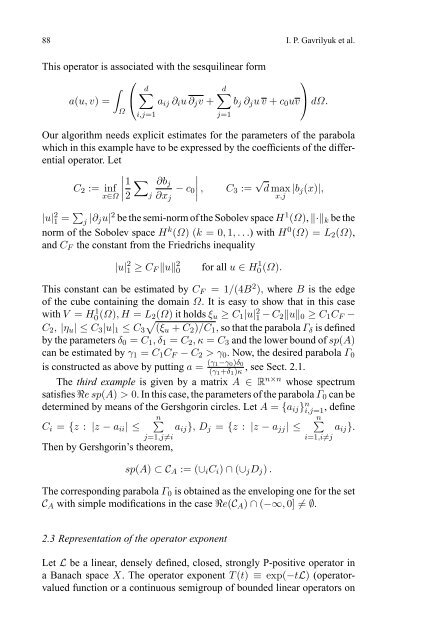H-Matrix approximation for the operator exponential with applications
H-Matrix approximation for the operator exponential with applications
H-Matrix approximation for the operator exponential with applications
Create successful ePaper yourself
Turn your PDF publications into a flip-book with our unique Google optimized e-Paper software.
88 I. P. Gavrilyuk et al.<br />
This <strong>operator</strong> is associated <strong>with</strong> <strong>the</strong> sesquilinear <strong>for</strong>m<br />
⎛<br />
⎞<br />
∫ d∑<br />
d∑<br />
a(u, v) = ⎝ a ij ∂ i u ∂ j v + b j ∂ j u v + c 0 uv⎠ dΩ.<br />
Ω<br />
i,j=1<br />
Our algorithm needs explicit estimates <strong>for</strong> <strong>the</strong> parameters of <strong>the</strong> parabola<br />
which in this example have to be expressed by <strong>the</strong> coefficients of <strong>the</strong> differential<br />
<strong>operator</strong>. Let<br />
C 2 := inf<br />
x∈Ω<br />
1 ∑<br />
∣2<br />
j<br />
∂b j<br />
∂x j<br />
− c 0<br />
∣ ∣∣∣<br />
,<br />
j=1<br />
C 3 := √ d max |b j (x)|,<br />
x,j<br />
|u| 2 1 = ∑ j |∂ ju| 2 be <strong>the</strong> semi-norm of <strong>the</strong> Sobolev space H 1 (Ω), ‖·‖ k be <strong>the</strong><br />
norm of <strong>the</strong> Sobolev space H k (Ω) (k =0, 1,...) <strong>with</strong> H 0 (Ω) =L 2 (Ω),<br />
and C F <strong>the</strong> constant from <strong>the</strong> Friedrichs inequality<br />
|u| 2 1 ≥ C F ‖u‖ 2 0<br />
<strong>for</strong> all u ∈ H 1 0 (Ω).<br />
This constant can be estimated by C F =1/(4B 2 ), where B is <strong>the</strong> edge<br />
of <strong>the</strong> cube containing <strong>the</strong> domain Ω. It is easy to show that in this case<br />
<strong>with</strong> V = H0 1(Ω),H = L √ 2(Ω) it holds ξ u ≥ C 1 |u| 2 1 − C 2‖u‖ 0 ≥ C 1 C F −<br />
C 2 , |η u |≤C 3 |u| 1 ≤ C 3 (ξu + C 2 )/C 1 , so that <strong>the</strong> parabola Γ δ is defined<br />
by <strong>the</strong> parameters δ 0 = C 1 ,δ 1 = C 2 ,κ= C 3 and <strong>the</strong> lower bound of sp(A)<br />
can be estimated by γ 1 = C 1 C F − C 2 >γ 0 . Now, <strong>the</strong> desired parabola Γ 0<br />
is constructed as above by putting a = (γ 1−γ 0 )δ 0<br />
(γ 1 +δ 1 )κ<br />
, see Sect. 2.1.<br />
The third example is given by a matrix A ∈ R n×n whose spectrum<br />
satisfies Resp(A) > 0. In this case, <strong>the</strong> parameters of <strong>the</strong> parabola Γ 0 can be<br />
determined by means of <strong>the</strong> Gershgorin circles. Let A = {a ij } n i,j=1 , define<br />
C i = {z : |z − a ii |≤<br />
n ∑<br />
j=1,j≠i<br />
Then by Gershgorin’s <strong>the</strong>orem,<br />
a ij },D j = {z : |z − a jj |≤<br />
sp(A) ⊂C A := (∪ i C i ) ∩ (∪ j D j ) .<br />
n ∑<br />
i=1,i≠j<br />
a ij }.<br />
The corresponding parabola Γ 0 is obtained as <strong>the</strong> enveloping one <strong>for</strong> <strong>the</strong> set<br />
C A <strong>with</strong>simple modifications in <strong>the</strong> case Re(C A ) ∩ (−∞, 0] ≠ ∅.<br />
2.3 Representation of <strong>the</strong> <strong>operator</strong> exponent<br />
Let L be a linear, densely defined, closed, strongly P-positive <strong>operator</strong> in<br />
a Banachspace X. The <strong>operator</strong> exponent T (t) ≡ exp(−tL) (<strong>operator</strong>valued<br />
function or a continuous semigroup of bounded linear <strong>operator</strong>s on
















